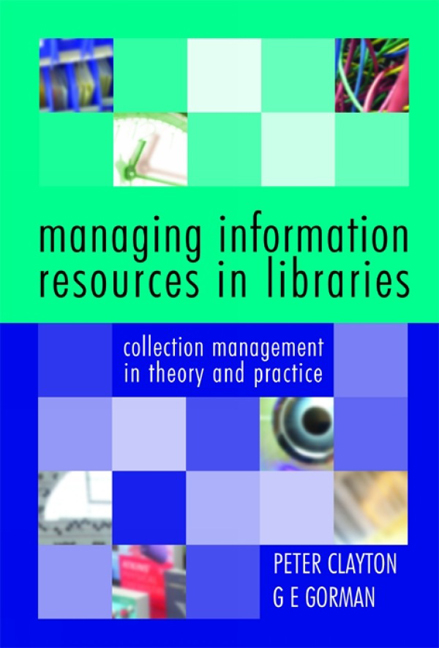Book contents
- Frontmatter
- Contents
- About the authors
- Preface
- 1 Managing information resources in context
- 2 Collection management and collection development policies
- 3 Conspectus
- 4 Resource sharing and co-operative collection development
- 5 Selection: policies and procedures
- 6 Selection resources
- 7 Acquisitions processes and procedures
- 8 Budget management
- 9 Collection evaluation and review
- 10 Preservation and weeding
- The literature of collection management Adela Clayton
- Index
6 - Selection resources
Published online by Cambridge University Press: 08 June 2018
- Frontmatter
- Contents
- About the authors
- Preface
- 1 Managing information resources in context
- 2 Collection management and collection development policies
- 3 Conspectus
- 4 Resource sharing and co-operative collection development
- 5 Selection: policies and procedures
- 6 Selection resources
- 7 Acquisitions processes and procedures
- 8 Budget management
- 9 Collection evaluation and review
- 10 Preservation and weeding
- The literature of collection management Adela Clayton
- Index
Summary
Focus questions
• How does one establish the existence, availability and price of resources?
• What is the role of reviews in selection?
• In what ways might publishers’ and booksellers’ advertising assist?
This chapter takes as its starting point the proposition that selectors are faced with a series of decisions, some relatively small and easy, others relatively difficult and costly. To increase the probability of being right more often than wrong, it is essential to be armed with as much up-to-date and accurate information as is conveniently available. This will not guarantee the selection of only the necessary and best resources, but it should increase the likelihood of being right more often. As in all practical endeavours, there comes a time when the decision must be made regardless of the completeness or otherwise of the available information – to go beyond this time is not good professional practice.
In this chapter the various kinds of selection tools are divided into classes, and characteristics of the classes described. There are many problems with this approach, including the initial problem of devising a classification scheme, deciding which are the characteristics that distinguish one group from another, and deciding how to recognize and measure these characteristics. But if the aim is to understand the nature of selection tools, then general guidance of this kind rises above the detail of which tools happen to be available today, and should allow some underlying principles to be understood.
Any selection tool should do either or both of two things; if it does neither, it is worthless, but if it does both it can be remarkably useful:
• It must identify the item, and provide the selector with enough information to allow him or her to decide what the item is; that is, it must act as an alerting device.
• It must evaluate the item, or tell the selector whether the item is any good for its stated purpose, and if it is not, in what particulars it fails; that is, it must act as an evaluating device.
- Type
- Chapter
- Information
- Managing Information Resources in LibrariesCollection Management in Theory and Practice, pp. 102 - 117Publisher: FacetPrint publication year: 2006



